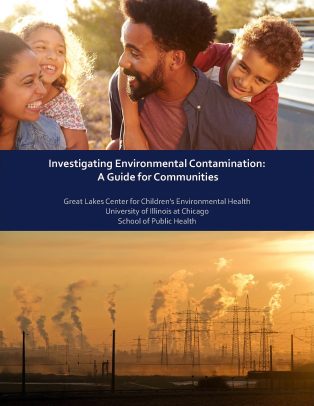A ‘how to’ guide for communities concerned about pollution

The Great Lakes Center for Children’s Environmental Health at the University of Illinois at Chicago School of Public Health has published a guide for Great Lakes region community members who are concerned about environmental exposures in their neighborhoods.
The guide provides information and resources that will help people determine if contamination is affecting the health of residents in their community. It covers air, water, and soil pollution and provides specific resources for people living in Minnesota, Wisconsin, Illinois, Indiana, Ohio and Michigan.
“We wrote the guide book in response to questions we receive at the Great Lakes Center all the time from people wondering how to find out what kinds of environmental toxins might be in their communities and what they can do about it,” said Dr. Susan Buchanan, clinical associate professor of environmental and occupational health sciences in the UIC School of Public Health and director of the Great Lakes Center. “We designed the guidebook to be a single resource that contains information on how to investigate potential sources of pollution, and lists several websites where people can zoom in on their own neighborhoods to identify sources of toxins.”
Businesses must report their releases of pollutants, and much of the information on which chemicals and how much has been released, both recently and historically, is publicly available on government websites such as that of the U.S. Environmental Protection Agency, Buchanan explained.
“By compiling all this information in one place, we hope to empower people to educate themselves and take action,” Buchanan said.
In addition to its sections on air, soil and water pollution, “Investigating Environmental Contamination: A Guide for Communities,” addresses lead contamination issues and features sections about resources online and advocacy.
“We have instructions on how someone can put together a ‘power map’ of people in their communities who can help address or bring greater attention to environmental exposures because they are in a position of power—an elected official or leader of an environmental organization,” Buchanan said.
One of the websites highlighted is TOXMAP, a tool created by the U.S. National Library of Medicine. It graphically represents the locations Superfund sites, coal plant emissions and nuclear power plants and is overlaid with health data from the National Cancer Institute, demographic data from the U.S. Census and income data from the U.S. Department of Commerce.
The Great Lakes Center for Children’s Environmental Health is a regional Pediatric Environmental Specialty Unit funded by the U.S. Environmental Protection Agency and the Agency for Toxic Substance and Disease Registry to promote and protect children’s health through prevention, education, diagnosis and treatment of environmentally related diseases. It is housed within the UIC School of Public Health.
Susan Kaplan, research assistant professor, and Emily Szwiec, research associate, in the department of environmental and occupational health sciences in the UIC School of Public Health, are co-authors of the guide book.
